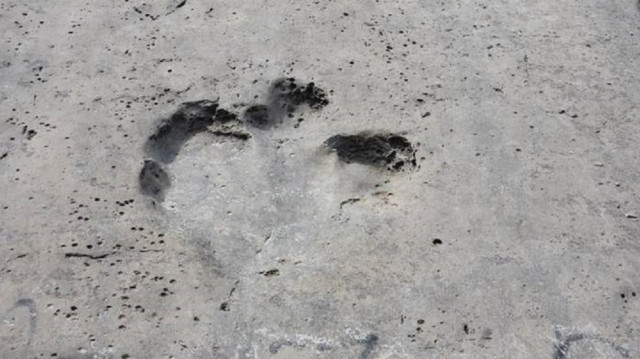
Footprints dating back to the Middle Jurassic Period, around 166 million years ago, trackways form part of huge 'dinosaur highway'
Some 200 giant footprints, belong to dinosaurs 166 million years ago have been found at a quarry in Oxfordshire, becoming the UK's largest footprint site.
Researchers from the Universities of Oxford and Birmingham have uncovered a huge expanse of quarry floor filled with hundreds of different dinosaur footprints, creating multiple enormous trackways, the University of Oxford announced on Thursday.
The new discovery showed the footprints dating back to the Middle Jurassic Period --around 166 million years ago-- the trackways form part of a huge "dinosaur highway" and include footprints from the nine meter ferocious predator Megalosaurus, and herbivorous dinosaurs up to twice that size.
The statement noted that the dig, that was carried out at Dewars Farm Quarry in Oxfordshire, uncovered five extensive trackways with evidence of more in the surrounding area.
"Four of the trackways were made by gigantic, long-necked, herbivorous dinosaurs called sauropods, most likely to be Cetiosaurus, an up to 18-metre-long cousin of the well-known Diplodocus."
The fifth trackway was made by the carnivorous theropod dinosaur, Megalosaurus which had distinctive, large, three-toed feet with claw.
"Scientists have known about and been studying Megalosaurus for longer than any other dinosaur on Earth, and yet these recent discoveries prove there is still new evidence of these animals out there, waiting to be found," said Emma Nicholls, vertebrate palaeontologist at Oxford University Museum of Natural History.
The footprints were buried under mud but came to light after quarry worker Gary Johnson felt "unusual bumps" as he was stripping the clay back with his vehicle, in order to expose the quarry floor.
It followed by the experts were called in as he Universities of Oxford and Birmingham co-led a team of more than 100 people on a week-long excavation in June 2024.
They painstakingly uncovered around 200 footprints and built detailed 3D models of the site using aerial drone photography – documenting the footprints in unprecedented detail for future research.
"These footprints offer an extraordinary window into the lives of dinosaurs, revealing details about their movements, interactions, and the tropical environment they inhabited," said Kirsty Edgar, professor of Micropalaeontology at the University of Birmingham.

